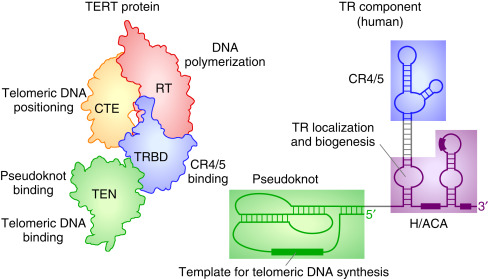What is TERT Protein
The telomerase reverse transcriptase (TERT) protein is a catalytic component of the enzyme telomerase, an essential player in cellular longevity and proliferation. The discovery of TERT dates back to the late 1980s, when biologists Elizabeth Blackburn and Carol Greider unearthed a novel enzyme responsible for the replication of telomeres, the protective DNA-protein complexes at chromosome ends. Over three decades, our understanding of TERT's structure, function, and associated diseases has dramatically expanded.
The TERT gene locates on chromosome 5 (5p15.33) in humans. The encoded TERT protein is a ribonucleoprotein that assists in the replication of the telomeric DNA for cell division. The TERT protein structure comprises a reverse transcriptase domain that carries out the enzymatic function, a telomerase RNA binding domain, and an essential N-terminal domain. Simply stated, the unique protein structure enables TERT to continually synthesize and extend the telomeric DNA, thus maintaining chromosomal integrity.

Fig1. TERT Structure (J.J.-L. Chen, 2016)
Function of TERT protein
The main function of the TERT protein is to counteract the natural shortening of telomeres. When cells divide, the DNA replication machinery cannot completely replicate the end of the chromosomes, causing telomeres to shorten. This gradual attrition eventually triggers cellular senescence or apoptosis. TERT intervenes in this process, adding DNA sequences to the telomeres, hence enabling cell survival and continued growth. Additionally, TERT is also involved in DNA damage repair, mitochondrial function regulations, and other cellular protection and adaptation mechanisms.
Embryonic stem cells, germ cells, and some adult stem cells express TERT highly, offering these cells with unlimited replicative potentials. In a stark contrast, most somatic cells lack sufficient TERT and hence are subjected to telomere shortening and aging. However, many cancer cells cunningly re-activate TERT, attaining immortality. The TERT protein is intricately regulated at multiple levels such as transcription, alternative splicing, post-translational modifications, protein-protein interactions, and subcellular localization, contributing to the complexity of the TERT protein-related signal pathway.
TERT protein related diseases
Dysregulations in the TERT protein or its associated pathways are implicated in numerous diseases. The most notable is cancer. Mutations that re-activate TERT or intensify its role are found in many tumor types including glioma, melanoma, hepatocellular carcinoma, and bladder cancer. Cancer cells use these mutations as a strategy to endlessly proliferate and resist anti-cancer therapies. On the other hand, insufficiency or loss of TERT function results in telomere syndromes with aging properties such as pulmonary fibrosis, dyskeratosis congenita, and aplastic anemia. Intriguingly, TERT is also linked to non-fatal conditions like male infertility, myocardial infarction, diabetes, rheumatoid arthritis, Alzheimer's disease, and others.
TERT protein's applications in biomedical
Given its immense importance in cellular longevity, TERT is a promising target in biomedicine. Its telomere-maintaining capacity can be harnessed for regenerative medicine, potentially repairing damaged tissues and extending healthy lifespans. Furthermore, the discovery that the TERT protein may have non-telomeric roles, such as in mitochondrial protection or DNA repair, introduces new perspectives for potential TERT-based treatments. In oncology, therapeutic strategies aiming at TERT seem intriguing. TERT inhibitors could be used to unmask the Achilles' heel - the telomere maintenance mechanism of cancer cells, paving the way for effective anti-cancer therapies.
In conclusion, TERT is more than just a 'telomere-extending' enzyme. Its functions extend far beyond, with implications for health, aging, and diseases like cancer. As the field of telomere biology continues to grow, it is expected that our understanding of the TERT protein and its multiple roles and modes of regulation will continue to deepen, revealing new possibilities for therapeutics in aging and cancer.
Our Featured Products
| Cat.No. | Product Name | Species | Source (Host) | Tag |
|---|---|---|---|---|
| TERT-4175H | Recombinant Human TERT Protein, His (Fc)-Avi-tagged | Human | HEK293 | His (Fc)-Avi |
| TERT-438H | Recombinant Human TERT Protein, His/GST-tagged | Human | E.coli | His/GST |
| ERT-056H | Recombinant Human TERT protein, His-tagged | Human | E.coli | His |
| Tert-1383M | Recombinant Mouse Tert Protein, His-SUMO-tagged | Mouse | E.coli | His/SUMO |
| TERT-9132M | Recombinant Mouse TERT Protein, His (Fc)-Avi-tagged | Mouse | HEK293 | His (Fc)-Avi |
| TERT-5673R | Recombinant Rat TERT Protein, His (Fc)-Avi-tagged | Rat | HEK293 | His (Fc)-Avi |
Reference
- J.J.-L. Chen, J.D. Podlevsky, Molecular Cell Biology, in Encyclopedia of Cell Biology, 2016

